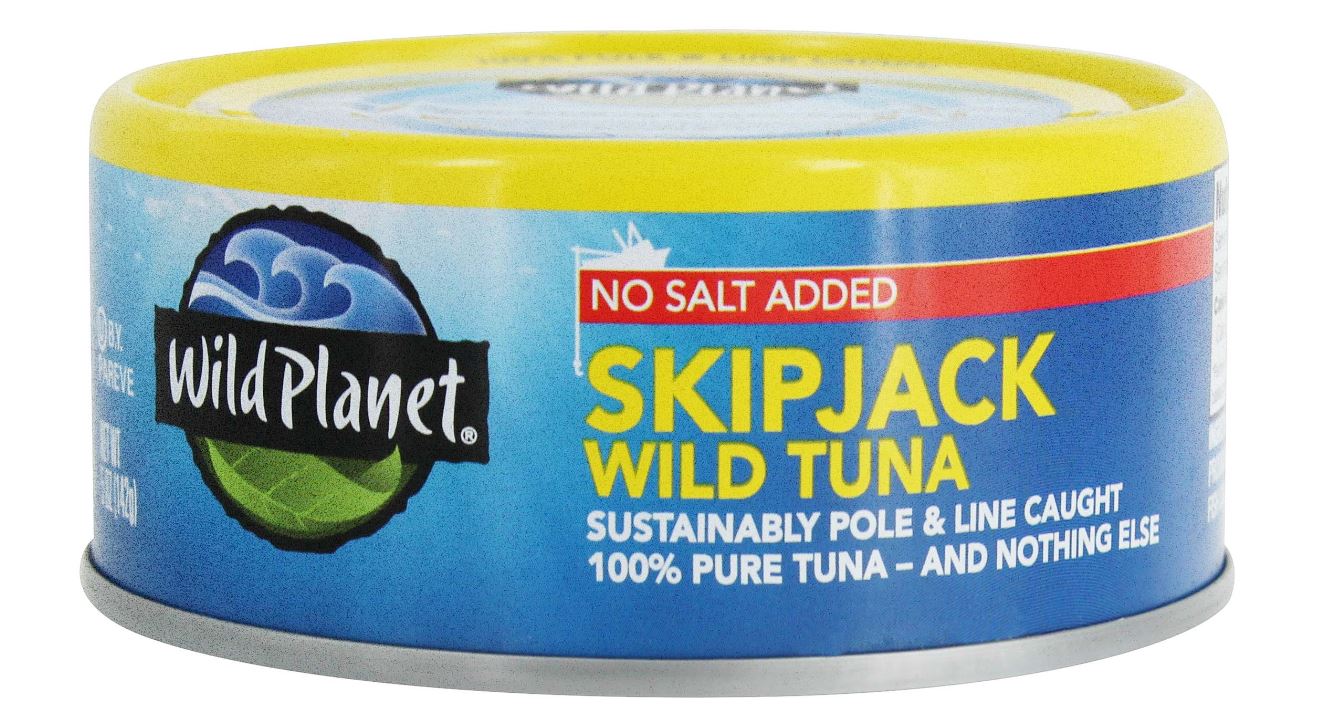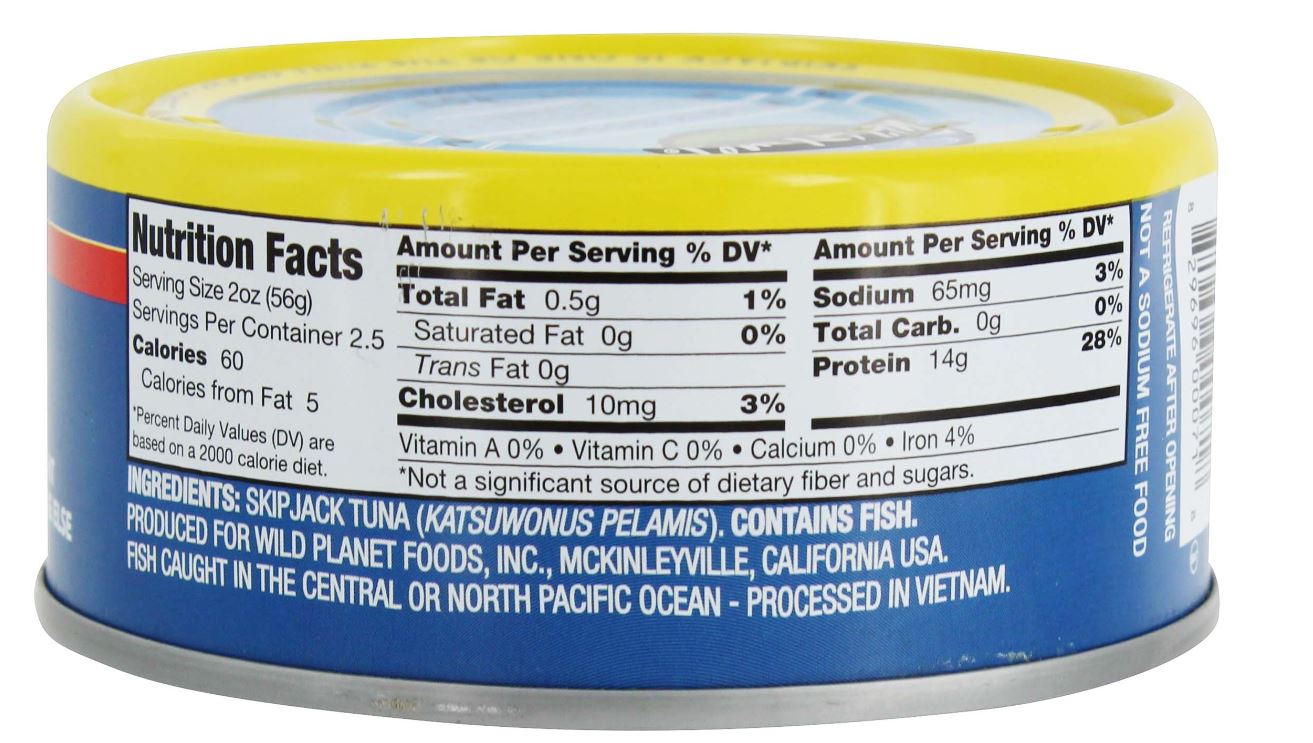Overview
Description
Wild Planet - Skipjack Wild Tuna No Salt Added - 5 oz. (142g)
Wild Planet Skipjack Wild Tuna No Salt Added is light in color with big tuna flavor. Wild Planet offers the first sustainably caught skipjack tuna on the market without added salt, perfect for tuna salad, tuna pasta sauce or your family’s favorite tuna casserole. Wild Planet skipjack wild tuna is hand packed raw into cans without added oil, water or fillers and cooked once to retain the abundant Omega 3. No need to drain the natural juices – they’ll enhance your meal with pure flavor.
- Non GMO Project Verified
- OU Kosher Pareve
- No Salt Added
- Gluten Free
- 100% pole and line caught
- Fish caught in the Central (Western Central Pacific Skipjack) or North Pacific Ocean (North Pacific Skipjack)
- BPA Free Lining
Albacore and Skipjack Tuna
Wild Planet sources albacore and skipjack tuna only from pole and troll fisheries. Numerous fleets around the world use this artisanal small-scale method and deserve support. This catch method is considered a best choice in harvest technique by the consensus of
international environmental organizations studying this issue.
Wild Planet may expand their sourcing as needed from other troll and pole fisheries, all of which are nearly by-catch free and are not overfished. no purse seine or long-line caught tuna will ever be used in their products.
Salmon
Wild-caught salmon from Alaska is considered a best choice for sustainability as per the recommendations of the Monterey Bay Aquarium Seafood Watch program. Pacific salmon caught in Alaska are among the most intensively managed species in the world, with excellent monitoring of both the fish populations and the fishery itself.
Sardines
Pacific Sardines are considered to be a "Best Choice" for sustainability as their populations appear to be healthy and abundant. Having recovered from a natural decline in population in the 1960s, Pacific Sardines are prolific breeders that mature quickly and whose numbers are currently experiencing a high growth rate. Migratory in nature and travelling in large schools from Baja Mexico to Vancouver BC, Wild Planet Sardines are sustainably harvested in a well managed fishery with negligible bycatch or habitat damage. Pacific Sardines are versatile and flavorful, each a nutritional powerhouse packed with protein, CoQ10, Calcium, Iron and Potassium. Sardines are also an important link in the food web, as seabirds, marine mammals and other fish rely on sardines as the basis of their diet.
Traceability
All purchases made of tuna products are documented by dolphin safe and certificate of origin certificates which indicate:
- Vessel name and license
- Captain name and license
- Country vessel registration
- Harvest method
- Area of capture
- Trip dates of capture
- Dolphin safe declaration
These data points provide the basis to determine that the fish landed are actually derived from the fisheries determined to be conservation best choices. Verification of these facts are confirmed by Wild Planet personnel through documentation audit and vessel inspection. Traceability of products by vessel name is documented and maintained in the transit, storage and production of finished goods.
Pole & Troll
In most cases, canned tuna labeling does not include information on the catch method. If it is absent, you can likely assume the worst. Wild Planet sources tuna caught only by trolling or pole and line. There is virtually no by-catch (<0.5%) associated with the trolling or pole and line techniques, which are regarded as the best fishing methods for tuna, a fact worth remembering when you buy.
Pole and troll caught tuna are considered the very best method for sustainability by a consensus of many Non-Government Environmental Organizations. Wild Planet is proud to be in compliance with the green standards of Monterey Bay Aquarium Seafood Watch, Blue Ocean Institute, Ocean Wise, Sea Choice and Fishwise. Greenpeace has also evaluated Wild Planet tuna products and has rated them as a top brand for sustainable sourcing policies.
Troll-Caught Albacore
Commercial fishing vessels that harvest younger surface-swimming albacore are called "jig boats" because they fish with jigs. They are also called "trollers" since they "troll" for albacore.
"Trolling" means to catch fish by towing a lure or baited hook behind a slow-moving boat. In the albacore fishery, trollers attach ten to twenty fishing lines to the vessel's outriggers. These fishing lines are of different lengths and are also spread out along each outrigger to help prevent them from getting tangled up with each other.
Attached to the end of each line is a jig, which is a rubbery fishing lure with a hook in it. Jigs are shaped to look like squid and come in a wide variety of colors. The jigs are trailed in the water behind a moving boat, and some albacore will bite a squid-like jig and get hooked. The hooked albacore is immediately removed from the water and prepared for freezing.
Because jigs are designed to catch fish on the ocean's surface, they simply cannot reach the older, larger albacore that swim in deep waters far below the surface. This is why other types of fishing gear are used to catch older albacore, and why "troll-caught albacore" always refers to the younger, tastier, Omega 3 rich albacore.
Pole & Line
Pole and line fishing has been practiced for centuries in several different parts of the world. The method involves attracting a school of tuna to the side of a "bait-boat" by throwing live sardines and anchovies overboard. This creates a tuna "feeding frenzy" and fish are hauled out of the water, one-by-one, using pole and line. The size of the tuna caught this way is small, mostly consisting of albacore and skipjack, but also some yellowfin and bigeye.
Dangers of Bycatch
Most fisheries catch unwanted animals along with their target catch. This non-target catch, known as "bycatch", is normally thrown back into the ocean, dead or dying. Tuna fishing is no exception to this rule. Longlines, for instance, can catch sharks, rays, sea turtles, seabirds and many species of fish. Globally, it has been estimated that 200,000 loggerheads and 50,000 leatherback sea turtles are hooked by longlines every year.
Purse seines are no better, with bycatches consisting of a diverse array of marine life, including dolphin fish, billfish, wahoo, triggerfish, barracuda, rainbow runners, sharks and sea turtles, especially when used in conjunction with floating objects (known as fish aggregating devices, or "FADs" - used to attract schools of tuna).
Wild Planet FAQ
How long has Wild Planet been in business?
The company was founded in 2004 by William Carvalho and Bill McCarthy. These two industry veterans, with a combined 50 years of experience, wanted to start a company that addressed the need to preserve the natural marine habitat while still harvesting wild seafood. It is their vision that these needs can successfully co-exist. Wild Planet Foods emerged from this vision with a product line of eco-preferable wild seafood. The natural ocean ecosystem is an abundant food production resource that must remain that way; the name Wild Planet arose from this concept.
How are Wild Planet fish caught?
Wild Planet tuna are caught individually using pole and troll methods. This ensures that no other marine life is caught or harmed in the process, unlike long-line and FAD (fish aggregating device) purse seine methods which are employed by many national companies and endanger other marine species. Wild Planet's salmon, sardines and anchovies are "free school" purse seine caught which means no FADs are used to attract the fish.
Where do the tuna come from? Are they wild or farm raised?
Wild Planet carries only wild caught products. Their albacore tuna comes from pole and troll fleets in the North Pacific working in the United States and Japan. They also source a smaller amount of albacore from pole and troll vessels working in New Zealand and the southern Pacific waters. Wild Planet skipjack and yellowfin tuna are pole caught in Indonesia and Japan by small-scale family fishing vessels.
Where are sardines and anchovies sourced?
Wild Planet sardines are caught in the North Pacific and come from both California and Japan. Their white anchovies are caught in Peru.
Are Wild Planet albacore and skipjack tuna packed in water or oil?
They place hand-cut sashimi grade tuna steaks in each can, retaining all the natural juices and Omega 3 oils, without adding any liquid. This is 100% pure tuna and sea salt so there is never any need to drain. An exception to this method is their tuna packed in extra virgin olive oil.
Why is Wild Planet tuna higher in calories than conventional brands?
Since they pack their tuna in its natural juices all of the Omega 3 oils are present and these oils contain calories. The added water in conventional tuna is devoid of both nutrition and calories. This is why Wild Planet tuna is highly potent nutritionally.
Why is the Omega 3 content higher in Wild Planet tuna?
Wild Planet cooks their tuna only once, in the can, retaining all of its natural oils. Most conventional brands cook their fish before putting it in the can and adding oil or water thereby losing much of its nutritional value.
Why is there less mercury in Wild Planet albacore tuna as compared to conventional brands of tuna?
The 9 to 25 pound pole and troll caught albacore from the North Pacific are much smaller and younger than long line caught older fish that can reach up to 70 pounds after 10 to 15 years of growth. The older fish accumulate more mercury over time.
How is Wild Planet's offering of smaller, younger fish consistent with a sustainability mission when these fish haven't had a chance to breed?
There are two fishing segments targeting albacore worldwide; surface fisheries which catch migratory juveniles and deep-water long-line which captures spawning stock. The West coast pole and troll fisheries capture less than 15% of the bio-mass which means that 85% of the fish will return to spawning stocks. This escapement is acceptable in order to sustain the population of the species.
Why is Wild Planet tuna more expensive than the large national companies such as Bumble Bee or Starkist?
Wild Planet uses only the highest quality raw materials and in addition, their sustainable harvesting methods are more expensive and yield less product in comparison to long-line caught fish. Their tuna is hand-cut and packed, a labor-intensive process, so that you get a whole steak in every can - 5 ounces of fish compared to 3.5 ounces of fish and the rest water, as found in conventional tuna brands. In the end, the taste and nutritional value are vastly superior to the competition.
Is there mercury or other chemicals in Wild Planet salmon?
All of their salmon are wild-caught from clean, clear waters in the U.S. and Canada. Because of their shorter lifespan, they do not have the chance to accumulate higher amounts of mercury.
Are there phosphates in Wild Planet shrimp?
Never. In keeping with their high standards for additive-free seafood, Wild Planet shrimp comes to you in a natural, healthy state.
Why are Wild Planet tuna and sardines caught in the U.S. but packed in Vietnam?
The last sardine factory in the U.S. closed in 2010 and there is no tuna cannery capable of processing their volume. Cost of production in the U.S. would also increase the retail price of Wild Planet products, making them difficult for the average family to afford. In order to support their mission of making sustainable seafood choices mainstream and accessible, Wild Planet has elected to process their albacore and skipjack tuna, as well as their sardines, in a state-of-the-art partner facility in Vietnam.
What is the carbon-load of producing these products overseas?
Wild Planet has studied this issue carefully and have concluded that ocean freight is one of the lowest carbon-load forms of transportation on the planet. The carbon load of 26 tons of tuna traveling from Seattle to Vietnam is much lower compared to local fish that is trucked or flown around the country every day.
Are Wild Planet products gluten-free?
All Wild Planet products have been tested for the presence of gluten by a third party testing agency. The results indicate ZERO parts per million detected - their products are 100% gluten free. Wild Planet attributes these results to the fact that their products naturally do not contain gluten - they simply pack fish and salt into their tuna and salmon canned products.
Do Wild Planet products contain soy or soy-based ingredients?
None of their products contain soy in any form. Unlike many brands of tuna, Wild Planet tuna does not contain vegetable broth, hydrolyzed vegetable proteins or any other liquids or fillers, which often do contain soy. Wild Planet tuna is packed in its own natural juices, and certain varieties do include sea salt. Their sardines and anchovies are packed in either water, olive oil or marinara sauce, which do not contain soy. Wild Planet salmon is packed similarly to their tuna products - simply the natural juices from the fish itself and salt. Wild Planet shrimp is packed with natural citric acid as well as water and salt.
Why do I occasionally see a brownish coloring on one side when I open a can of tuna?
This brownish coloring is the result of not cooking fish in a can of liquid. The natural fat and juices that cook out during the Wild Planet once-cooked process are not enough to surround all sides of the fish thereby producing an almost caramelized effect. This produces a far superior taste as compared to boiling it in a can of oil or water.
Why are Wild Planet sardines so solid as compared to other brands?
When a fish is really fresh and brought down quickly in temperature it has a firmness and density that is uncommon in most fisheries. They hold up very well during the cooking process in the can resulting in a fish that remains whole and intact. Some people find Wild Planet sardines to be drier as their firmness prevents them from soaking up the liquids they are packed in. Simply break up the fish a bit to absorb the oil or sauce if you prefer a moister meat texture.
Does Wild Planet use packaging containing BPA?
No BPA is used in Wild Planet's can lining.
About Wild Planet
Wild Planet is committed to providing the finest tasting sustainably caught seafood while supporting the conservation of wild marine ecosystems.
Wild Planet offers a full line of top quality seafood with fresh-from-the-sea flavor. In order to adhere to the highest standards of sustainability possible, each product in their line is carefully researched according to the reports generated by leading environmental organizations. From Wild Plant's great tasting tuna, salmon and sardines to their brand new white anchovies, they're sure you'll agree that nothing compares to the flavor, nutrition and value offered by Wild Planet.
Suggested Use
Pop can open, use in a sandwich or on a salad.
Ingredients
| Wild Planet - Skipjack Wild Tuna - 7.5 oz. (212g) | |||||||||||||||||||||||||||||||||||||||||||||||||||||||||||||||||||||||||||||||||||||||||||||||||||
|
|||||||||||||||||||||||||||||||||||||||||||||||||||||||||||||||||||||||||||||||||||||||||||||||||||
| Other Ingredients: Skipjack Tuna (Katsuwonus Pelamis) | |||||||||||||||||||||||||||||||||||||||||||||||||||||||||||||||||||||||||||||||||||||||||||||||||||
Questions & Answers
2 Reviews
Needless to say, after a week or so I quit using. They need to be smoother and actually have the ability to dissolve.





















It works!
Recommended by a friend
trying a new brand of zinc lozenge
Good for colds etc..